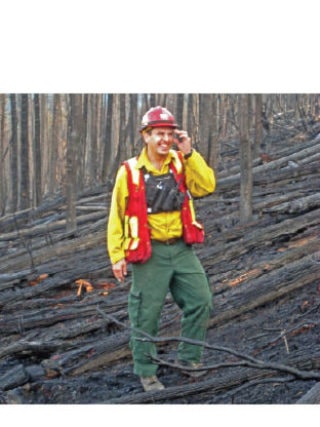Having given a very cool reception to the province’s attempts to “download” fuel management on Crown land, local fire officials are a little warmer to suggestions being made by an experienced fire ecologist.
Co-author of the Filmon Report, commissioned after the province’s destructive and costly 2003 wildfires, Robert Gray says the province has not followed up on recommendations regarding the reduction of forest fuels in B.C.
Gray says forest policy in B.C. has not changed and that timber/fibre production maximization remains the primary objective driving forest management – with no attention paid to the long-term need to reduce wildfire hazard.
But removing forest fuels is the number-one priority in managing wildfires, he says.
“Vegetation continues to grow and die, which adds fuel every year, and it’s the number one issue,” he says. “We have to take the heat out of the fire.”
While the province has tried to encourage communities to clear out dangerous fuels in surrounding Crown land through community wildfire protection plans funded through the Union of British Columbia Municipalities, Gray says they have not made the program palatable.
As well, he points out, the province has approached fuel reduction on an isolated project base rather than a province-wide program basis.
When communities were first encouraged to participate in the fuel reduction program in 2009, Salmon Arm Fire Chief Brad Shirley expressed disappointment with how it was rolled out, the costs incurred by the community to train and compensate workers and the ongoing nature of the responsibility.
“So much of our concern is that the areas of concern are outside the community, so why should the city manage that whole system?”
Columbia Shuswap Regional District Fire Services Co-ordinator Jack Blair was, and continues to be concerned about the vast size of the regional district, most of it forest.
Gray acknowledges their concerns.
“If communities are going to treat Crown land when the hazard grows back, you have the responsibility in perpetuity,” he says. “One way around that is if the province makes the land your responsibility and then you get all the resources that go with it.”
Under the current system, if a community takes on the liability, they have to pay stumpage on trees they harvest and then they have to apply for grant to clear brush. And they have to use taxpayers’ dollars because grants only cover 75 per cent of the costs, Gray says.
Gray is currently working with the municipalities of Kimberly and Cranbrook and two First Nations bands to develop a proposal for how communities can reduce fuel and benefit in the process.
“If you set out this buffer for communities, it will become self-funding, and there will no longer be a requirement for government to subsidize – if it all works out well.”
Gray says some government officials have expressed informal support for his ideas.
“I have been received well by those that realize it’s the only way we’re going to get fuels management in place,” he says. “We’re always gonna have them (fires), but they won’t be so destructive.”
As well, he points out, the loss after a wildfire is huge compared with the “fraction of the costs of doing fuel treatment.”
Shirley, meanwhile, says Gray’s concept is interesting and “without knowing all details certainly appears more attractive than the current system.”
But he still considers fuel management to be downloading and, once again suggests such programs be run by forest companies.
“I’d certainly be willing to sit and listen to the fella,” says Blair. “If the money stays in the community and works with the community then I think communities, particularly in the North Shuswap would be interested.”
Blair notes that with the adoption of the fire services review, the regional district will be looking at a public education program and, with that, various ways and methods to minimize the risk of interface fires in and around CSRD communities.
